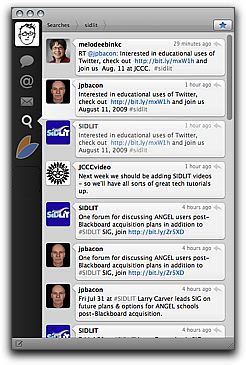How I use Twitter at conferences (or, don't just read about it; do it)
Kansas City's SIDLIT conference is next week, and conference organizers are promoting Twitter use this year with numerous links to guides on "how" to use it. I'm not going to forward these links any further; most of them are academic and show little to no evidence that the people who wrote them have actually used Twitter in conference environments.
Academics think too much, if you ask me. The best way to figure this out is to do it. Rather than write a multi-page outline, backed by cited references and academic jargon, I'm going to distill what you need to do in as few steps as possible:

- Get a Twitter account, if you don't have one already. It's free and takes like two minutes to start; four minutes to add a photo and fill in a short bio.
- Get a Twitter client with built-in search. I was using TweetDeck at SXSW this past spring–it's feature-rich and cross-platform (Adobe AIR required). I've since moved to the Mac-only client Tweetie because I like its simplicity. You can also use Twitter's web client to search, but I like having a standalone app.
- Find out what your conference's hash tag is. You know those words you see in people's posts like #sxsw or #followfriday or #SIDLIT? Those are hash tags. Most conferences these days have one identified early on–they are key to making Twitter a usable, social tool for any event. If your conference doesn't have a hash tag identified, take charge and make one. There aren't any rules, other than it should start with a # and be as short as possible, to provide more room for your message.
- Add the hash tag to your stored Twitter searches. In TweetDeck, create a new column for the search. In Tweetie you can do this by clicking the magnifying glass icon. Again, you can use Twitter's web interface if necessary. Do this before the conference starts to begin to get a feel for who else is using Twitter at the event.
- Start tweeting. If your post is related to the conference, make sure the conference hash tag is included. In spite of what some of the academics say, there aren't any strict rules about this. At SXSW I used Twitter as a notepad, recording anything I wanted to remember at any given talk. Did that annoy people who were following me prior to the conference? Perhaps, but I don't care, and neither should you–use Twitter for yourself, not for everyone else. Chances are you're going to find more people who find what you're saying interesting than people you annoy. Now, all that said, if you feel more comfortable posting one salient takeaway from each session, or each day, go for it.
- Keep up with what others are saying. This part takes some getting used to, especially if you're not used to multitasking, but once you get the hang of it you won't see how you got along at a conference without Twitter. This is one nice thing about TweetDeck's multi-column display; you can keep one eye on the event's hash tag search and one eye on everything else. With Tweetie I'll probably spend most of my time focused on the #SIDLIT search results and ignore the rest of my life, catching up on the latter during breaks. What might you see? Depending on who else is using Twitter, you might be able to get a glimpse at what's being discussed at other sessions, or grab a good point from someone sitting in the same room as you (hint: retweet it to add it to your own stream).
- Decompress, then recapture. Within 24 hours, take a few minutes to review what you posted, and ideally recapture it in some way. For SXSW, I posted blog entries summarizing each session, using my Twitter activity as notes. As John Medina says in Brain Rules, "repeat to remember" and "remember to repeat." Even if you feel like this isn't necessary for memorization purposes, keep in mind that Twitter's built-in memory is fleeting. Your tweets' lifespan is relatively limited, so if you have any interest in posterity whatsoever, record a backup somewhere.
As for me, I plan on tweeting like heck during SIDLIT, at least when I'm not presenting. If you're interested, feel free to follow me at @ruralocity. See you Thursday!
. Questions or comments? Let me know what you think.